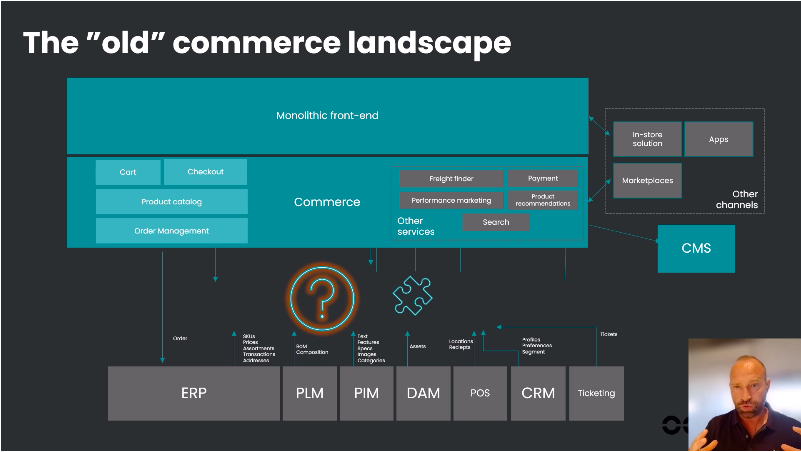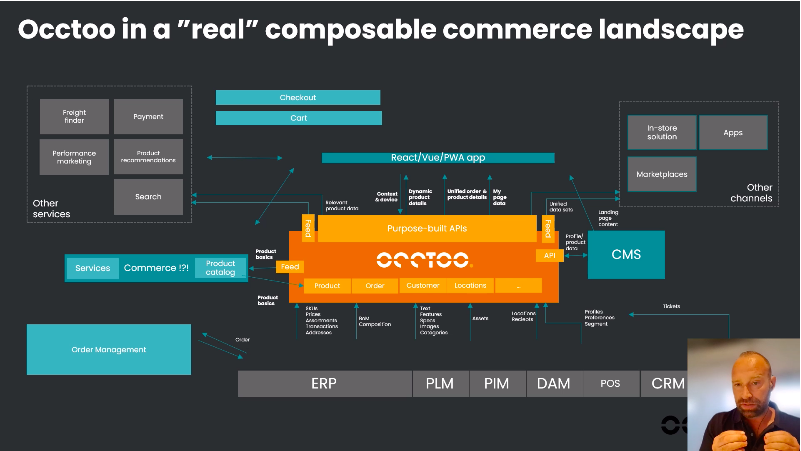The concept of Composable Architecture is to have self-sustained systems providing support for individual functionality or sources of data while sharing all of this using various APIs. Read more in our quick guide to understanding Composable. A major benefit is that you can have dedicated, best-of-breed systems working on specific tasks or functionalities. These systems can be hosted internally or be offered in a cloud service or as a full SaaS.
This article is transcribed from the webinar "How Occtoo help you switch to Composable Commerce" that was hosted by our CTO and co-founder, Jimmy Ekbäck on the 31st of November 2022.
Would you prefer to watch the video instead? Scroll to the bottom of this page to watch in full.
In this article you will get a brief overview of how Occtoo enables you to in unlock and combine the data from your separate systems, deliver the data you need to individual API's and move to a Composable tech stack.
The first step is to turn your Enterprise data into Experience data - what do I mean?
Create relevance and activate your data
A big drive for Occtoo is the huge app explosion, contextualised apps using real-time data and reusing data from enterprise processes to meet customer needs.
Your organization likely handles tons of data across various systems: your PIM/PLM area, your WMS or OMS, and your CRM - This data is in an Enterprise state. This way of storing data slows the data down and using the data outside the core application is harder and it is not scaled for servicing external requests when building customer-facing applications.
In the Experience state, the data is fast, and easy to unify, segment, filter, and distribute using simple tools that your digital team has access to at their fingertips. You should be able to create application-specific data endpoints only containing the data needed in a matter of minutes and not days or weeks, WITHOUT lengthy integrations!
To turn Enterprise data into Experience data it must be stripped down into its simplest form, making it free from its old data model.
Occtoo removes the existing structure from your data and pushes it from its original source through Occtoo. It then rebuilds that purpose and that structure in order to make it available fast and repurpose it for the different needs and different frontends.
See documentation for developers here.
How do we see Composable commerce evolving overtime?
The old commerce landscape there is a monolithic frontend. Everything is in one code base and it's not easy to change. The data is inside the commerce tools. There is something missing within this - how do we make this work together and avoid the endless backlogs for delivering what needs to be delivered?

Here is how Occtoo sees the new composable landscape ...
How do you make your system of records data available to the frontend? Occtoo is the answer to this. Occtoo unifies, mitigates and feeds that into the frontend system.

Your frontends should be as thin as possible. You can look at the function of commerce as delivering API's in order to create transactions, and then look at the frontends as separate things. If Occtoo on-boards your data and makes sure your commerce has it's data it, but your frontend experiences are created from REAL experience data from Occtoo. You can create multiple experiences and decide what that experience will be. You have your unified data in Occtoo and create destinations and API's providing the experience, and in Occtoo these are in real-time, so you can create these really relevant experiences.
This the future of composable architecture and the way we see the composable stack.
